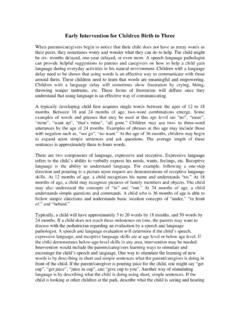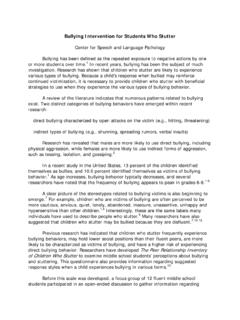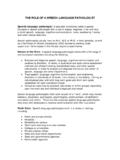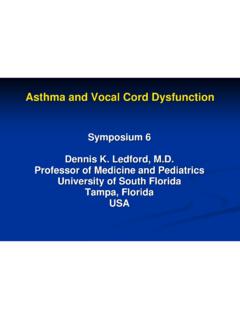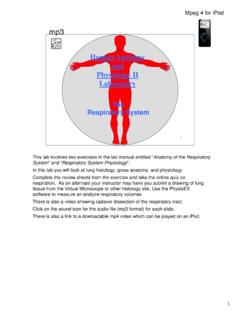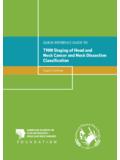Transcription of voice What's New - speechtherapyct.com
1 voice Disorders The voice is resilient to many harmful behaviors; however, in certain cases chronic abuse to the voice can cause a voice disorder. The voice can be abused and/or misused causing damage to the vocal folds. vocal abuse is considered poor vocal hygiene. vocal behaviors which are abusive to the voice include the following: yelling, screaming, cheering, straining the voice , talking excessively, clearing the throat excessively, coughing excessively, mouth breathing, consuming caffeine, smoking, singing with inappropriate techniques, and speaking in an abusive manner when the vocal folds are swollen due to allergies or an upper respiratory infection (URI).
2 vocal misuse is a behavior that results in increased tension at the level of the larynx. Elevated or decreased ( , whispering) vocal loudness and elevated or decreased pitch levels are considered examples of vocal misuse. voice disorders among children are very common. A child s voice might sound hoarse, breathy, strained, fatigued, or raspy. These disorders of the voice may be congenital or acquired. A child who screams excessively, overuses his/her voice ( a cheerleader), has many URIs, or has reflux may be at risk for a voice disorder.
3 voice disorders in adults are more common among singers, professional speakers, and teachers; however, vocal abuse or misuse can lead to a vocal pathology in any adult. Some factors associated with adult voice disorders are smoking, environmental pollutants, and abuse/misuse of the voice . The voice may sound raspy, breathy, and/or strained. An adult may also sense that something is lodged in the throat causing harmful throat-clearing behaviors. Pain or discomfort in the throat may also be present. If an adult or child experience the symptoms described above, the symptoms should be presented to a primary care doctor or an otolaryngologist.
4 An otolaryngologist, (Ear, Nose, and Throat doctor) who specializes in diagnosing voice disorders, can determine the problem and provide recommendations. Some of the more common vocal pathologies are laryngitis, nodules, polyps, paralysis/paresis, hemorrhage, and spasmodic dysphonia. Laryngitis can be caused by an URI, allergies, or reflux. The voice may sound lower or higher in pitch. There may be many voice breaks or periods of aphonia ( , absence of a voice ). When laryngitis is present, the vocal folds are swollen and sore.
5 Resting the voice and drinking plenty of fluids are key components in treating laryngitis. vocal fold nodules can be caused when the voice is overused or misused. The voice may sound raspy or breathy. A person with nodules might experience vocal fatigue or voice breaks. Nodules resemble calluses. Due to excessive abuse, calluses form at the point of most stress on the vocal folds. Knowing how to use the voice properly is a key component in treating vocal nodules. Breathing exercises, increasing daily hydration, and talking at a comfortable level may be some of the areas addressed in therapy.
6 vocal polyps can be caused by chronic abuse/overuse, reflux, or an URI. Polyps can also occur as the result of a single traumatic event ( , yelling at a sporting event). The voice may sound rough, breathy, or strained. Polyps are similar to nodules; however, they are larger in size. Learning how to use the voice effectively and how to avoid abusive vocal behaviors are key components of voice therapy for prevention or treatment of polyps. vocal fold paralysis/paresis ( , weakness) can be caused by nerve damage, trauma to the neck, or surgery ( , thyroidectomy).
7 The voice may sound breathy, strained, or hoarse. One or both vocal folds can be affected. The vocal fold or folds can be paralyzed in an open or closed position. Treatment is dependent upon the position of the paralyzed vocal fold(s). vocal fold hemorrhage is mostly caused by a single traumatic vocal event or trauma to the larynx. The voice may sound hoarse. There may be some periods of aphonia and decreased pitch range, especially the upper range. The treatment plan is primarily dependent upon the severity of the hemorrhage.
8 Spasmodic dysphonia can be caused by an URI or a traumatic emotional event. The voice may sound breathy, strained, hoarse, harsh, and/or tremor-like. The treatment of spasmodic dysphonia is determined by its presentation. Circumlaryngeal massage is one effective treatment technique. This technique reduces muscle tension in the muscles surrounding the larynx. Changes in voice should be brought to the attention of a physician. Following assessment, an otolaryngologist can make recommendations for the type of treatment required to regain optimal use of the voice .
9 Center for Speech and Language Pathology

